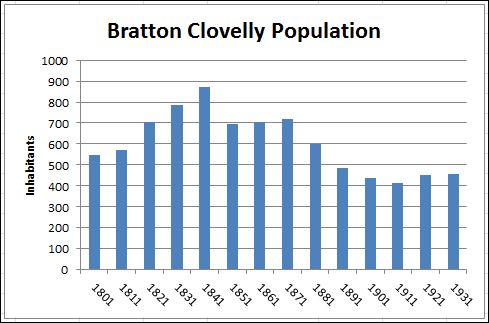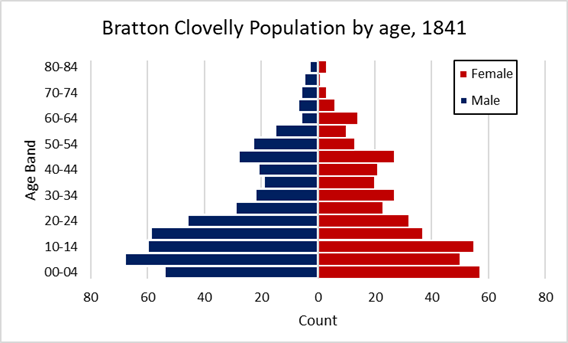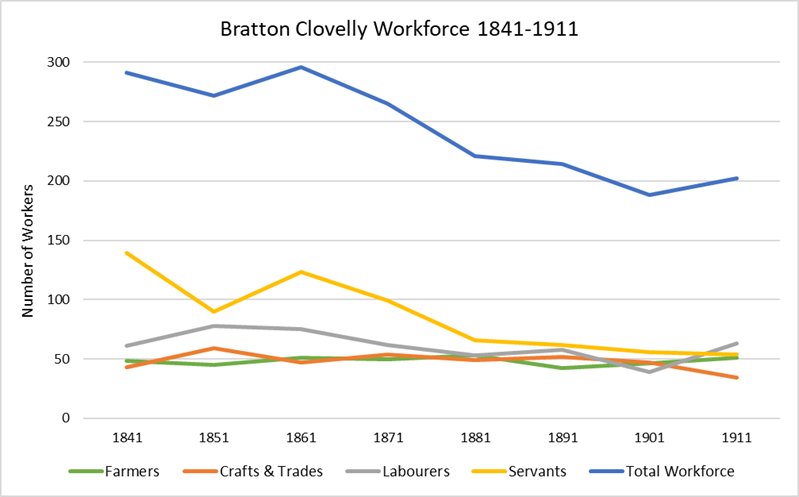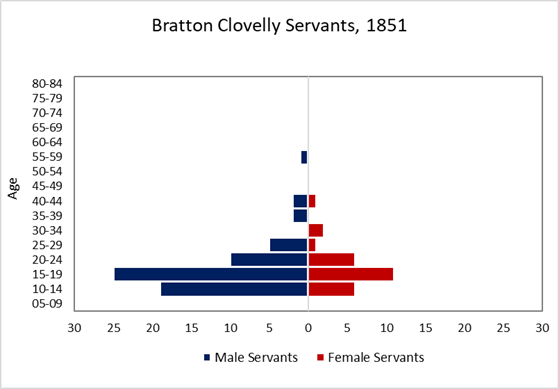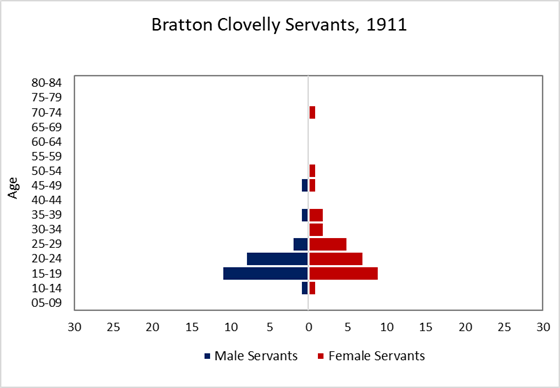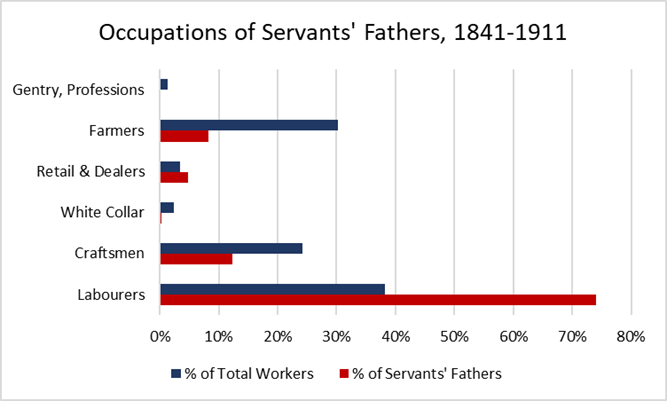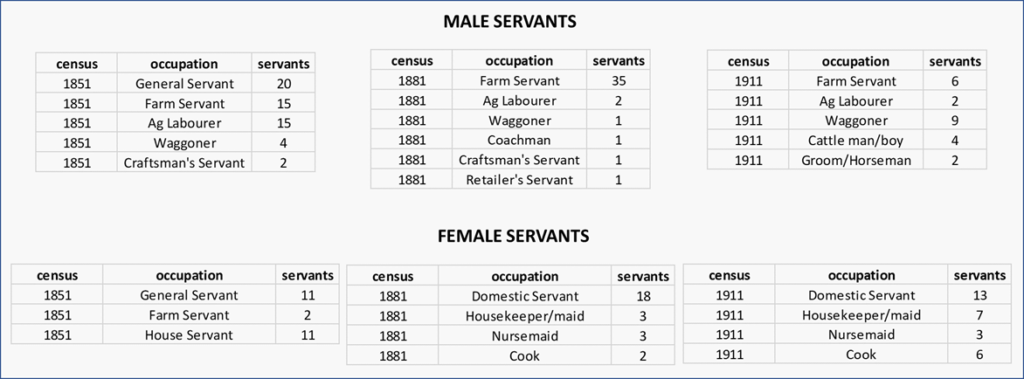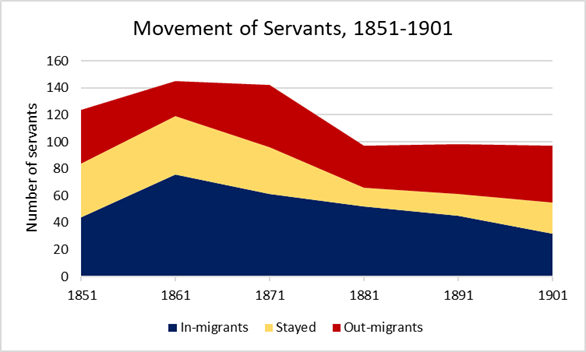The following paper was published in Destinations, the newsletter of the Society for One-Place Studies, in June 2020. For a brief overview of all occupations in Bratton Clovelly, see the Occupations page.
The Young Servants of a West Devon Parish
Kim Baldacchino, June 2020
Throughout the census years and probably long before, servants were central to the economic and social life of the parish of Bratton Clovelly, Devon. They were the biggest part of the local workforce in the 19th century and the evidence suggests that they helped to stabilise the adult workforce during a period of rapid de-population in the latter half of the century. They brought diversity to their community through local migration and marriages. Just as importantly, young servants learned to live away from home in a generally protective environment, built skills needed for their livelihood as adults, had the opportunity to begin saving for their future independent households and, all the while, reduced the cost and space burden to their parents who often had younger children to attend to.
The purpose of this study is to identify the characteristics of servants in this rural parish, the types of work they were engaged in and their movement. The study makes use of previous work where record linkage was used to identify close to 3,000 unique residents of Bratton Clovelly in the censuses of 1841 to 1911, including linkage not only from census to census but also to baptisms, marriages and origins and destinations of those who came into or out of the parish.
The definition of ‘servant’ varies in census enumeration reports and academic studies. For the purpose of this study, servants are defined as those who have a relation of ‘servant’ in the census enumerations of ‘relation to head of family’ or, particularly for the 1841 census where relations were not recorded, those who have no relation specified but whose rank, profession or occupation is listed as servant. This definition emphasises the live-in nature of the servants, generally hired on a yearly basis and wage although younger servants may have begun service with accommodation, food and necessities only. This definition also distinguishes servants from those performing farm and domestic duties on the farms and in the trades of their own families, a type of presumably unpaid work inconsistently recorded in the censuses. Although some studies report that live-in servants on farms had dwindled by the mid-1800s in other regions of England, primarily in large arable farm regions, the practice persisted throughout the century on the sheep and cattle farms of West Devon and other similar regions.
The Bratton Clovelly Workforce
Bratton Clovelly became an early victim of Victorian rural depopulation, losing over half of its population between 1841 and 1911. Ravenstein, in his well-studied ‘laws of migration’ based on national trends in 1871-1881, attributed such depopulation to the attraction of people to economic centres such as towns, cities and the fast-growing industrial centres. However, this was not the case for Bratton Clovelly, varying like many other local studies from national explanations.
Like the rest of the nation, Bratton Clovelly grew rapidly in the first half of the 19th century, more than doubling in size to almost 900 people. This resulted in a very large increase especially in the young people of the parish. Alternative industries were not available due to a lack of coal, water resources and transportation options and the parish’s 50 or so farms could not sustain such an increase. One response was that many young families emigrated overseas, accounting for close to 40% of the population decrease from 1841 to 1911. The other major contributor to re-establishing equilibrium was the young people of the parish who absorbed the change through the institution of service and the law of supply and demand. The balance of servant in- and out-migrants within the local area could flex in response to economic conditions, keeping the adult workforce relatively stable and placing the youth in the types of jobs and locations where labour was needed.
Who were the servants?
Unsurprisingly due to the definition of servants as ‘live-ins’, 98% of Bratton Clovelly’s male servants and 97% of the female servants in this time frame were unmarried. In general, parishioners established their own households at the time of marriage and occupational changes could be expected. For example, male servants often became agricultural labourers or farmers while female servants often became wives with young children and no listed occupation by the time of the following census.
The age and sex distribution of the servants varied through the course of the census years. In 1851, males comprised almost three-quarters of the servants in the parish. By the end of the period, females slightly outnumbered males albeit in a much smaller servant workforce. The change in size of the overall number of servants was partly due to the great population loss in the parish but another reason also becomes apparent. Throughout the census years, the most prevalent age group amongst servants was the 15- to 19-year-olds. However, earlier in the period there was also a very large group of 10- to 14-year-olds. By 1911, this younger group was almost entirely gone, impacted by the increasing age requirements of education legislation. The Board School log book and minutes are replete with the frustrations of schoolmasters and mistresses at the absence of especially the older boys for the Spring potato season as well as the Summer and early Autumn for the harvest. The impact was at least as great on parents, one even writing the Board to demand payment for their children to attend school rather than parents having to pay for the schooling. The young workers, whether as servants or as part of their family businesses, were a key component of the families’ economic well-being and it was only through legislation that the economic basis on which the families depended changed.
The numbers for servants over the age of 19 begin to show the impact of marriage. Marriages were relatively late in the parish, with the average and median ages of residents who married between 1835 and 1904 being 27 for males and 25 for females. Age at marriage varied little over the course of the census years.
Using fathers’ occupations in baptism records available for about 75% of servants, the large majority of servants were found to be children of agricultural labourers. On average through the census years, agricultural labourers were about 25% of the workforce compared to being 74% of the fathers of servants. Some children of retailers, craftsmen and farmers also worked as servants but in much lower proportions. Overall about 65% of unmarried workers under the age of 30 were servants. Preliminary analysis of those not working as servants indicates that virtually all were living with their families and most were listed without occupations, probably indicating they were busy on family farms or in other family businesses.
What work did they do?
Over 95% of male servants and over 90% of female servants in Bratton Clovelly worked on the larger of the 50 or so farms of the parish, the farms being on average 150 acres. The small number of servants in the village can be almost fully explained by the relatively large number of servants employed by the vicar along with a handful at the parish’s two inns, reducing during the census years to the one that remains today. Households with servants had an average of 2-3 servants living in the homes of their employers, accounting for about a third of the total household size throughout the census years.
Servant occupations were often non-descript in the census enumerator books, for example the 1841 census mainly recording ‘M. S.’ or ‘F. S.’ for male or female servants. Changes can be detected over time though such as the disappearance of the description ‘General Servant’ early in the census period. By 1881, males were mostly labelled as ‘Farm Servants’ while females were mostly labelled as ‘Domestic Servants’. However, such categorisation may be more about the standardisation of occupational categories rather than a good reflection of the work that the young people were actually undertaking.
Various studies have shed light on the work of young men and women in these roles. There were undoubtedly differences in the tasks undertaken by males and females and these differences became more pronounced as heavier and more mechanised field equipment was adopted through the Victorian period. Men’s occupations show increasing differentiation of the field work that all were involved in during much of the 19th century into more specific roles distinguishing those with waggoner skills or skills in the care of cattle and horses. For the females, the distinction was probably not as simple as ‘indoor’ versus ‘outdoor’ work. Rather, females had a variety of responsibilities within the home but were also frequently tasked with dairy work, care and feeding of animals and tending to gardens and orchards. At peak times such as the harvest, all hands took part in the great variety of tasks that had to be done in compact timeframes. Even so, as reflected in the increasingly differentiated occupation descriptions, specialist roles in housekeeping, nursing and cooking evolved through the century. Considering the age bands previously shown, the increasing specialisation reflected in the occupations seems to align with the increasing age and experience of the female servants.
On the move
Servants were a mobile group and the rate of movement, when viewed in light of a rapidly decreasing total population, did not diminish over the census years. Note that the early ramp-up of servants was in response to a major loss of the parish’s population to overseas emigration between 1841 and 1861. The heavy impact of emigration was reported in census summaries and labour shortages across North and West Devon were identified in newspapers of that period.
Considering those who moved into the parish for servant roles, those who were already in the parish when taking on servant roles and those who left the parish for servant roles in other locations, a somewhat higher percentage of servants came from within the parish early in the census years with later years witnessing even higher migration rates. It seems that movement was not only in response to supply and demand but probably also an attractive aspect of the occupation.
Servants did not have to travel far to achieve the structural changes needed in individual parishes. Almost 80% of those who migrated into Bratton Clovelly for servant roles came from villages and hamlets within 10 miles, with over 90% from within 20 miles.
Summary
Servants may be overlooked in occupational surveys, perhaps because servant roles are often vaguely defined and the servants as a group are migratory. Yet they can play a central role in the economic and social health of Victorian communities. In the case of the rural parish of Bratton Clovelly, the young unmarried servants formed the largest part of the workforce throughout the 19th century and contributed much to the stability and diversity of the place.
References:
Alan Armstrong, Farmworkers in England and Wales: A Social and Economic History 1770-1980 (Iowa State University Press, 1988).
Mary Bouquet, Family Servants and Visitors: The Farm Household in Nineteenth and Twentieth Century Devon>+ (Geo Books, 1985).
Nigel Goose ‘Research in Progress: Farm Service in Southern England in the Mid-Nineteenth Century’, Local Population Studies, 72, (Spring 2004), pp. 77-82.
Amy Kussmaul, Servants in husbandry in early modern England (Cambridge University Press, 1981).
Karen Sayer, Women of the fields: Representations of rural women in the nineteenth century (Manchester University Press, 1995).
Nicola Verdon, Rural Women Workers in 19th-Century England (The Boydell Press, 2002).
Caroline Verney with Janet Few, ‘Is blood thicker than water? Farm servants and the family in nineteenth-century north Devon’, Local Population Studies, 91, (Autumn 2013), pp. 10-26.
